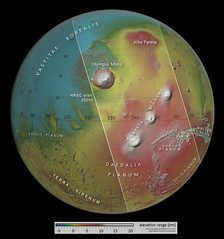This VIS image shows a cross section of the eastern flank of Ascraeus Mons. Ascreaus Mons is the northernmost volcano of the three large Tharsis volcanoes. In order from north to south the volcanoes are Ascreaus Mons, Pavonis Mons and Arsia Mons. All three volcanoes form a line located along a tectonic bulge caused by extensional forces in the region. Along this trend there are increased tectonic features, collapse features, and additional lava flows that arose from the flanks of the volcanoes rather than just the summit. Like the other large volcanoes in the region, Ascraeus Mons is a shield volcano. Shield volcanoes are formed by lava flows originating near or at the summit, building up layers upon layers of lava. In shield volcanoes summit calderas are typically formed where the surface collapses into the void formed by an emptied magma chamber. Ascraeus Mons is the largest of the three volcanoes with a summit of 18km (11 miles) and a width of 460 km (286 miles). For comparison Mauna Kea - the tallest volcano on Earth - is 10.2 km tall (6.3 mi) measured from the base on the sea floor.
This martian scene spans 17 x 261 kilometers (11 x 162 miles). To see where on Mars this area lies, and to download high-resolution versions of the image go to themis.asu.edu/zoom-20250520a
See the Red Planet Report at redplanet.asu.edu for updates on Mars research and exploration. For more about Mars geology, check out the Mars-ePedia: marsed.asu.edu/marsepedia
For the latest THEMIS Mars images as received by mission scientists, see themis.asu.edu/livefrommars. To learn more about the THEMIS camera and its Mars images, see themis.asu.edu
This image is in the public domain and may be republished free of charge. If used, please credit it as NASA/JPL-Caltech/Arizona State University.



















